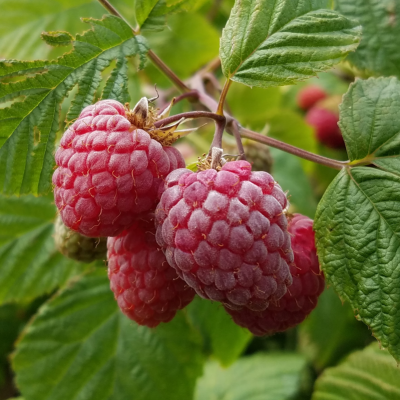 Red Raspberry (Rubus idaeus) is a perennial crop from the Rose family. Washington is a national leader in production and is responsible for approximately 95% of processed red raspberry production. Aggregate fruits (“berries”) develop on biennial canes that arise from a perennial root system. Canes are vegetative during their first year of growth and are referred to as primocanes. Primocanes develop flower/fruit buds that overwinter and produce a crop the subsequent season. These overwintered flowering/fruiting canes are referred to as floricanes.
Red Raspberry (Rubus idaeus) is a perennial crop from the Rose family. Washington is a national leader in production and is responsible for approximately 95% of processed red raspberry production. Aggregate fruits (“berries”) develop on biennial canes that arise from a perennial root system. Canes are vegetative during their first year of growth and are referred to as primocanes. Primocanes develop flower/fruit buds that overwinter and produce a crop the subsequent season. These overwintered flowering/fruiting canes are referred to as floricanes.
After harvest, floricanes are removed and the next cycle of primocanes are selected for production. Some types of raspberries produce a crop on primocanes and are referred to as fall-bearing or primocane-fruiting raspberries. The majority of production in Washington state and within the Pacific Northwest is from summer-bearing or floricane-fruiting raspberries.
Production Overview
- Commercial Red Raspberry Production in the Pacific Northwest (Pacific Northwest Extension Publication, 2007) (pdf)
This comprehensive publication provides a review on establishment, maintenance, soil and fertility, pest and disease management, and harvest/postharvest considerations. - Growing Raspberries & Blackberries in the Inland Northwest and Intermountain West (University of Idaho, 1999) (pdf)
Production guideline for the unique conditions of the Inland Northwest and Intermountain West. Topics include site preparation, maintenance, and pest and disease control.
Cultivars
- Raspberry Cultivars for the Pacific Northwest (Pacific Northwest Extension Publication, 2014)
Review of red, black, yellow, and purple cultivars of raspberry.
Site Preparation & Establishment
- Soilborne Disease and Nematode Management in a Changing Fumigation Landscape (pdf)
- Preplant Soil Fumigation and Alternatives for Berry Production (Washington State University, 2011) (pdf)
Overview of new EPA regulations on fumigation, fumigation techniques, and alternatives to broadcast fumigation.
Plant Maintenance
- Caneberry Nutrient Management Guide (Oregon State University Extension, 2006) (pdf)
Review of nutrient management, as well as soil and foliar testing. - 2015 Cost Estimates of Establishing and Producing Red Raspberries in Washington by S. Galinato and L.W. DeVetter (2016)
- Raspberry Management Schedule (British Columbia AgriFoodBC, last updated in 2012)
General guideline for plant and pest management
Fact Sheets and Articles
- Growing produce – Exploring soil-biodegradable plastic mulches in red raspberry
- Growing produce – Plastic mulches give raspberry production a boost
- Mechanically laying mulches in tissue culture raspberry
- Mulch use flow chart: Raspberry
- Plastic mulches suppressed weeds and increased red raspberry yield in a spring-planted field
- WSU WAM – Application of plastic mulches in raspberry – Year 1 results
Scientific Publications
- Zhang, H., C. Miles, M. Flury, H. Liu, and L.W. DeVetter. 2020. Soil-biodegradable plastic mulches undergo minimal in-soil degradation in a perennial raspberry system after 18 months. Horticulturae 6(3):47.
- Zhang, H., C. Miles, S. Ghimire, C. Benedict, I. Zasada, H. Liu, and L.W. DeVetter. 2020. Plastic mulches improved plant growth and suppressed weeds in late summer-planted floricane-fruiting raspberry. HortScience 55:565–572.
- Zhang, H., C. Miles, S. Ghimire, C. Benedict, I. Zasada, and L.W. DeVetter. 2019. Polyethylene and biodegradable plastic mulches improve growth, yield, and weed management in floricane red raspberry. Sci. Hort. 250:371-379.